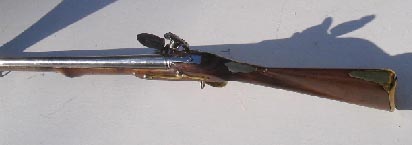



|

|

|
|
|               |
| A full view of the piece, which features a 34" barrel. The gun is 50" overall. |

|
| View from the left. |

|
| A view of the swell area. The original gun, although a private purchase musket, appears to have followed the 1742 Land pattern. |

|
| A view of the wrist and sideplate. |

|
| Here you can see the correct mid-century style triggerguard. |

|
| When the original gun was cut down, the rammer thimble and sling swivel had to be relocated. This reproduction shows them in their new location. Note the wooden rammer. |

|
|
For a long time now, people have been asking us for a "cut-down musket" or a "light infantry carbine" like the Rangers would have carried. The authenticity problem with that request is that a light infantry musket and a short musket are two different things. A correct LI musket of the F&I war era had a 42" barrel, hardly what I would call "short".
There are many examples of original muskets whose barrels have been cut back. Generally, this was done to "freshen out" a worn, dented or mushroomed muzzle. There are also many muskets that were cut down to make a hunting gun out of after their military career was over, much the way we would "sporterize" a 1930's Mauser today. Neither of these would be correct for Rangers to carry as they are no longer military weapons once so modified. After much soul searching and research, we have identified a single example of a Brown Bess musket that was obviously shortened on purpose, most likely for Ranger use or for some other irregular foot troops. If you are fortunate enough to own George Neumann's 1967 book "The History of the Weapons of the American Revolution", and turn to page 116 you will see it. It is also pictured, although in less detail, on page 65 of "Collector's Encyclopedia of the American Revolution". It is my understanding that the original gun is now on display at Valley Forge. The gun began life as a private-purchase Long Land Brown Bess. It seems to closely follow the 1742 pattern, but has no government markings on the lock or barrel. The barrel has private Birmingham proofs and the initials TP, the lock is marked Nickson. In researching these marks, I find no reference to a Nickson supplying arms to the Board of Ordinance, but several Nicholsons. There are several suppliers with the initials TP who predate the era of this gun, so the barrel may have been reused (my speculation). The triggerguard is of the type introduced on the 1742 pattern and the lock has no bridle. These clues place the original musket firmly in the early Seven Years War era. The bayonet lug has been relocated on the shortened barrel, which gives it a definite military history in it's shortened configuration. It is well known that Earl Stott unearthed barrel sections that had been cut off of muskets on Roger's Island in the 1960-61 digging seasons. This seems to give physical proof to the much-storied orders Rogers gave to his men to shorten their muskets. Interestingly, this single shortened musket is the only original piece fitting the description we could locate. It may be the only surviving "Ranger gun". Our reproduction of this special piece is based on this gun, but we have elected to use a pan bridle to make life easier on the reenactor who will need to install a flashguard. If you want to remove it to increase the authenticity of this unique piece, it is a simple enough job. Our reproduction has a 34" barrel in .75 caliber smoothbore. Overall length is 50". The lock and barrel on our reproduction uses the same markings as on our 1756 Long Land. Accessories for the Brown Bess, such as sling, hammerstall, flashguard, bayonet and period style tools are available separately. |